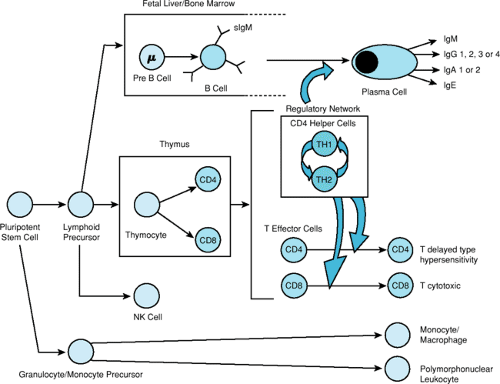The Immune System
Howard M. Lederman
The immune system is composed of a variety of cells (B lymphocytes, T lymphocytes, monocytes, and neutrophils) and their secretory products (antibodies, complement, and cytokines), which recognize foreign antigens and react to them. This chapter reviews the normal physiology of the immune system.
NORMAL IMMUNE SYSTEM
Components of the immune system are found in all parts of the body, but are concentrated in the thymus, bone marrow, lymph nodes, spleen, liver, and blood (Fig. 426.1). Successfully integrated and functioning together, phagocytes, the complement system, and B and T lymphocytes form an important homeostatic mechanism necessary for the host’s defense against infection and the generation of a normal inflammatory response. In conceptual terms, the components of the immune system can be divided into two compartments—innate and adaptive —each having fundamentally different modes of action (Table 426.1).
The Innate Immune System
The components of the innate immune system (neutrophils, macrophages, natural killer [NK] cells and complement) recognize foreign antigens through receptors encoded by intact germline genes (e.g., toll-like receptors and mannose binding lectin). These receptors bind to the pathogen-associated molecular patterns (PAMPs) that are shared by many microorganisms (e.g., bacterial lipopolysaccharide). The receptors for PAMPs are displayed nonclonally on cells of the innate immune system. For example, all neutrophils display one set of PAMP receptors, whereas all NK cells display a different set of PAMP receptors. Repeated exposure to an antigen does not alter the activity of the components of the innate immune system to that antigen.
Phagocytic Cells
Phagocytic cells ingest foreign antigens and microorganisms. Although many phagocytic cells are mobile and can move from the bloodstream through tissues to the site of microbial invasion or inflammation, other phagocytic cells are fixed in the sinusoids of the bloodstream and the lymphatic system where they clear microorganisms and other particulate matter from the circulation. A variety of cells possess phagocytic activity, but neutrophils, monocytes, and macrophages are the most critical to the functions of the immune system.
Neutrophils are large, polymorphonuclear leukocytes that arise in the bone marrow, circulate in the bloodstream, and migrate into tissues, where they are the first line of defense against local infections and the principal phagocytic cells of the acute inflammatory response. Monocytes also arise from stem cells in the bone marrow, circulate in the bloodstream, and migrate to the tissues, where they undergo morphologic and functional maturation to become macrophages. Monocytes and macrophages participate as effector cells in host defense and inflammation, but also can present antigen to lymphoid cells and secrete a variety of proinflammatory substances (including cytokines and complement components, among many others). Monocytes and macrophages thus play an important role in the generation of innate and adaptive immune responses.
Phagocytic Cell Movement and Binding
To function properly, phagocytic cells must attach to a substrate (adherence), move through tissues toward the site of microbial invasion (chemotaxis), attach and ingest microbes (phagocytosis), and finally kill them (intracellular killing).
Adherence to a substrate is a prerequisite before phagocytic cells can move. For example, phagocytes circulating in the bloodstream must adhere to vascular endothelium before they egress from the bloodstream. Similarly, once in the tissues, phagocytic cells adhere to connective tissue substrate as they crawl toward the site of microbial invasion or inflammation. The adherence of phagocytic cells is mediated by a family of cell-surface glycoproteins (integrins) including CR3, LFA-1, and p150,95. This adherence is enhanced by a number of soluble mediators, including C5a, thromboxane A2, leukotrienes, and platelet-activating factor.
Phagocytes also recognize microorganisms using the PAMP receptors that are expressed on bacteria and viruses but not by host cells (Table 426.2). For example, the macrophage mannose receptor binds specific sugar molecules found on the surface of many bacteria and viruses. A family of transmembrane receptors called Toll-like receptors (TLR) have specificity for
a variety of PAMPs. Binding to these receptors triggers a signalling cascade, with the induction of transcription factors and the activation of proinflammatory genes. One particularly important role for TLRs is to trigger macrophage responses to bacterial lipopolysaccharide (LPS). Bacterial LPS in body fluids is bound by the circulating LPS-binding protein, and this complex then binds to CD14 on the macrophage surface. When the LPS/LPS-binding protein/CD14 complex binds to TLR-4, the transcription factor NF-κB is translocated into the nucleus, where it activates genes involved in host defense such as tumor necrosis factor-alpha (TNF-α) and inducible nitric oxide synthetase.
a variety of PAMPs. Binding to these receptors triggers a signalling cascade, with the induction of transcription factors and the activation of proinflammatory genes. One particularly important role for TLRs is to trigger macrophage responses to bacterial lipopolysaccharide (LPS). Bacterial LPS in body fluids is bound by the circulating LPS-binding protein, and this complex then binds to CD14 on the macrophage surface. When the LPS/LPS-binding protein/CD14 complex binds to TLR-4, the transcription factor NF-κB is translocated into the nucleus, where it activates genes involved in host defense such as tumor necrosis factor-alpha (TNF-α) and inducible nitric oxide synthetase.
TABLE 426.1. COMPONENTS OF THE IMMUNE SYSTEM | |||||||||||||||
|---|---|---|---|---|---|---|---|---|---|---|---|---|---|---|---|
|
The directed movement of phagocytic cells toward a chemical stimulus is termed chemotaxis. The phagocytic cell senses chemical gradients across its length, and it moves in the direction of the higher concentration (i.e., the source of the chemotactic stimulus). A variety of substances act as chemoattractants. One of the more important stimuli is C5a, which is produced by activation of the complement system. Bacteria can release their own chemotactic peptides. In addition, a variety
of prostaglandins, monocyte-derived factors (monokines), and lymphocyte-derived factors (lymphokines) possess chemotactic activity. Together, these chemotactic stimuli cause phagocytic cells to migrate to and accumulate at sites of infection and inflammation.
of prostaglandins, monocyte-derived factors (monokines), and lymphocyte-derived factors (lymphokines) possess chemotactic activity. Together, these chemotactic stimuli cause phagocytic cells to migrate to and accumulate at sites of infection and inflammation.
TABLE 426.2. EXAMPLES OF RECEPTORS FOR PATHOGEN-ASSOCIATED MOLECULAR PATTERNS | ||||||||||||||||||||||||||
|---|---|---|---|---|---|---|---|---|---|---|---|---|---|---|---|---|---|---|---|---|---|---|---|---|---|---|
|
Stay updated, free articles. Join our Telegram channel

Full access? Get Clinical Tree








